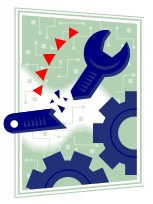Measure Cost of Poor Quality
Measures of Cost of Poor Quality can be divided into 4 distinct categories, each of which will be discussed in detail.
We calculate this metric not only to determine the overall sum of quality costs, but also to locate costs indirectly related to the initial problem cost.
Internal Failure Costs

Internal costs are the expenses incurred due to a failure to meet a customer requirement. Some examples of Internal Failure Costs are:
- Scrap- those items that cannot be repaired and must be discarded.
- Rework- the correction of errors in either product or service.
- Lost/ Missing Information-Looking for information that isn’t where is should be.
- Analysis of Failures- time spent to determine the cause of nonconformance.
- Supplier Nonconformances- rework, sorting, returning, supplied material.
- Containment Activity (100% inspection)
- Inspection/ Testing of Reworked Product- time spent to inspect or test reworked product.
- Process Changes- adapting the process to eliminate or minimize errors.
- Obsoleted Product- scrapped material due to process or product changes.
- Regrading of Product- rather than scrapping material, it is sold for a less money than a conforming product.
Other internal failure costs can be categorized as inefficient processes.
- Excessive Variation in Processes- even stable processes will occasionally product nonconforming product. Examination of the process variation and eliminating the “special causes” makes for better processes.
- Non-value added activity- in most instances, inspection, rework, sorting, movement, etc. is considered non-value added- it only adds cost to the process.
External Failure Costs
Costs corresponding to defects found after receipt by the customer are considered External Failure Costs.
Hard Costs
- Warranty- the cost to repair/replace under the terms of a contract.
- Customer Returns- not only the profit lost on the product, but the cost of replacement as well.
- Customer Complaints- time spent analyzing complaints, examining the relevant issues and the resolution of the issues.
Soft Costs
- Loss of Customer- yes, customers will void contracts due to poor quality. Additionally, many potential customers are asking for supplier data related to delivery, capability and/or yield. This data could cost your company a new customer.
Appraisal Costs
These are the costs related to determining conformance to requirements. These tasks are critical to the success of most organizations, yet are considered overhead… we can't bill the customer for these expenses.
- Inspection and Testing- these are considered non-value added activities unless your customer is paying you to inspect and test. Generally that's not the case. Also, any incoming and in-process inspections can be considered in this category.
- Material Utilized for Inspection and Testing- any resources consumed during the inspection/ test of product.
Prevention Costs
This category is actually not part of the calculation for COPQ. It is important, however, to be able to quantify these expenses so your organization begins to understand the importance of prevention. The really good news about prevention costs is that once the concept of prevention is embraced by management, we no longer have to measure it! Management will begin to focus on the improvement opportunities instead of the cost of prevention. Examples of Prevention Cost are as follows:
- Planning- included are the costs of planning beyond normal product and process design. In other words, we calculate only the amount of money spent on the methods used to eliminate or minimize defects- including the creation of procedures, work instructions, mistake proofing devices, etc.
- Process Control- inspections used to determine if the process is acting as planned. Statistical Process Control (SPC) would fit this grouping.
- Supplier Appraisal- knowing that your supplier can meet your company's requirements regarding quality, delivery, and customer service are also prevention costs.
- Training- time spent creating and presenting training programs related to quality. Remember, quality does not mean only "quality of the product or service." Quality relates to all functions of an organization.
Learn more about COPQ in our article about the importance of cost of poor quality.
Calculating Return on Investment
Since the language of top management is money, we can also calculate the Return on Investment, or ROI, as another summary measure of any improvement initiative. Management loves this metric, as it can detail the overall gain from the investment or the length of time until the break-even point (the moment your company has saved as much as it spent on the improvement).

Assume your company has an issue costing you $10,000 per month. In terms of annualized costs that's $120,000. Your team determines that your company needs to spend $5000 to completely eliminate this issue, including the time your team spent determining the solution. The result is an annualized ROI of 24 (120,000/ 5000 =24, your company is saving 24 times what it spent on the improvement) … management should be giving you a bonus!
But what if management wants to know how soon a new machine will pay for itself? We can also calculate this version of ROI as well. Here's an example (sorry for all the math).
You've been charged with finding a way to get more products out the door. You have an old clunky machine used in the creation of your product. It produces a unit every minute. You locate a sparkling new machine that does the same task, but it's much faster… only 15 seconds are taken to create the same product. What is the ROI from a time standpoint?
Let's make some assumptions for the sake of calculating this ROI. Assume that your total labor cost is $30 per hour (including benefits, etc.). So, you're spending $240 per day on labor for this machine.
The new machine costs $100,000. And it takes ¼ of the time that the old clunker takes. The new machine can do in 1 day what it takes the clunker 4 days to accomplish, or you'll spend $960 in labor costs to accomplish what the new machine can do in a day ($240) for a daily savings of $960- $240= $720.

Now, divide the daily savings into the cost of the sparkling new machine to determine how many working days until payoff. This calculation ($100,000/ $720) tells us that after 138.8 working days your organization has saved enough to pay for this machine. But, to clarify for management, try to state this ROI in terms of months or years. In this case, assume there are 22 working days in an average month and divide 138.8/ 22, which equals 6.31 months.
Remember, management thinks in terms of money… so if you can show them the money in terms of pain and payoff, and the numbers make sense, you're well on your way to becoming a hero within your organization.




